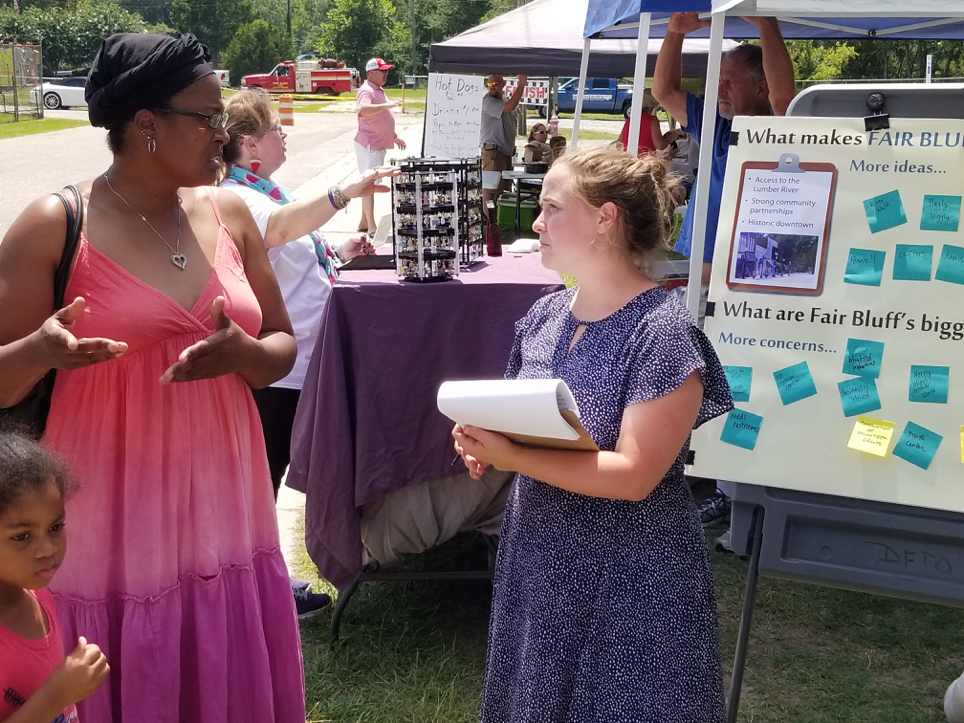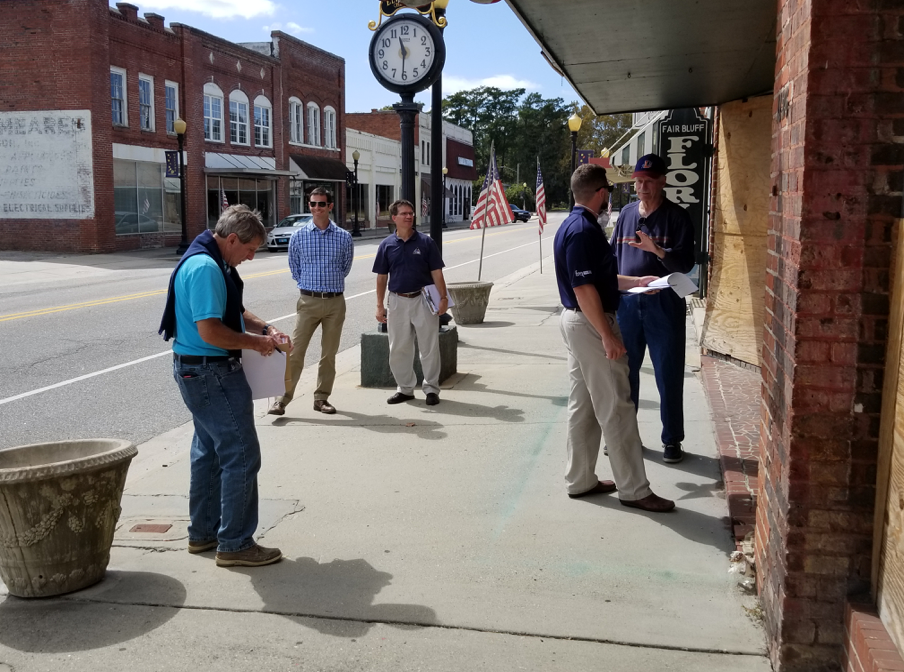This post originally appeared on the UNC Institute for the Environment blog.
Jessica Southwell is Project Manager for the Hurricane Matthew Disaster Recovery and Resilience Initiative, and coordinates work in six communities in eastern North Carolina impacted by Hurricane Matthew.
The Hurricane Matthew Recovery and Resilience Initiative is led by the Center for Natural Hazards Resilience at UNC-Chapel Hill, which also leads the Coastal Resilience Center of Excellence. The Initiative was started in early 2017 to address recovery concerns in six North Carolina communities.
A few months ago, local partners in Hurricane Matthew recovery sat at a six-top table at a diner in Kinston, N.C. We had spent the morning walking through the logistics for hosting an AmeriCorps team that would soon be in town, meeting just a few weeks following the one-year anniversary of Hurricane Matthew.
Our discussion soon turned to what it was like those first few days after the storm. Many discussed watching the river rise from their various posts in town, even in the days following Matthew when the sky had turned blue after dumping inches upon inches of rain on already drenched soil.
Everyone around the table had been through this before. When Hurricane Floyd hit North Carolina in 1999, residents believed the 500-year flood would be the only one they witnessed in a lifetime. Just 17 years later, in October 2016, the same residents were experiencing it again. Now, more than a year after Matthew, the topic of hurricane recovery in Kinston, and in communities across Eastern North Carolina, is still a regular, if not daily, part of the local conversation.

Kofi Boone, Associate Professor and University Faculty Scholar in the Department of Landscape Architecture at NC State University, listens to residents and town officials in Princeville reflect on design options that highlight the town’s historical significance and importance of community. Photo by Josh Kastrinsky.
Above: Kofi Boone, Associate Professor and University Faculty Scholar in the Department of Landscape Architecture at NC State University, listens to residents and town officials in Princeville reflect on design options that highlight the town’s historical significance and importance of community. (Photo credit: Josh Kastrinsky)
Unfortunately, residents across eastern North Carolina know a lot about the impact of hurricanes and what it will take for their communities to recover. What can those of us in academic institutions hope to add to the conversation to help make the local recovery process easier?
As project manager for the Hurricane Matthew Disaster Recovery and Resilience Initiative (HMDRRI)—an academic collaboration connecting resources between UNC, N.C. State University and local, state and federal partners—I know this to be true: The process and timeline of a town’s recovery begins and ends at the local level. We are most useful when we put ourselves in positions of support with the goal of increasing local capacity and supporting unmet needs, identified by local, state and federal partners. For the Initiative we’ve been leading – funded through the North Carolina Policy Collaboratory, North Carolina Emergency Management, U.S. Department of Homeland Security and North Carolina General Assembly – this means providing recovery planning assistance to six communities in North Carolina: Kinston, Seven Springs, Princeville, Windsor, Fair Bluff and Lumberton.

Meredith Burns (right), a graduate student in the Department of City and Regional Planning, met with residents during Fair Bluff’s annual Watermelon Festival, gathering and listening to ideas about what improvements they would like to see to make the town more resilient. Photo by Gavin Smith.
HMDRRI is based at the Coastal Resilience Center, a research and education consortium at UNC-Chapel Hill that works to enhance the resilience of the nation’s people, infrastructure, economies and the natural environment to the impacts of coastal hazards such as floods and hurricanes, including the effects of future climate trends.
Since early 2016, faculty, staff and students across UNC’s Department of City and Regional Planning and NCSU’s College of Design have worked closely with communities to listen, learn from and document what a resilient community looks like. In Princeville, this means thinking through issues around the importance of place and historical significance of the town. In August, HMDRRI hosted a Design Workshop with the goal of helping partners collaborate on design options for building a resilient Princeville. In Fair Bluff, a small community in Columbus County near the South Carolina state line, one could easily imagine the historic downtown and river walk developing into a thriving area, modeling growth off of efforts seen in communities like Wilmington and even Saxapahaw. Recently, a group of experts evaluated historic downtown structures in several of the Initiative’s priority communities and provided suggestions on how these buildings could support flood retrofit designs to be more resilient against future floods.

Coordinating with experts with the Association of State Flood Plain Managers (ASFPM) and the State’s Historic Preservation Office, HMDRRI staff visit with leadership from the Town of Fair Bluff during a workshop to identify potential flood retrofit recommendations for the historic downtown. Photo by Gavin Smith.
We are beginning to look at opportunities to address the policies and programs that will support each of these communities in their long-term recovery. We will next work with local officials and partners to identify an implementation strategy based on community priorities. We are also documenting the process, identifying lessons learned and opportunities to improve upon or replicate the successes we have seen by establishing partnerships across all levels of government.
These lessons are intended to show other states how this unique university-community-state relationship can be applied elsewhere, including in other United States locations and overseas. For instance, conversations are underway with Puerto Rico and the US Virgin Islands on how the Initiative can be replicated in these locations following Hurricane Maria. The overall work of the Initiative is closely aligned with a UNC-led International Learning Lab. HMDRRI, which represents the first node in the International Learning Lab, currently involves partners in Australia and Vietnam.
The central approach involves drawing from teams comprised of faculty, students, and practitioners which engage in assisting stricken communities, conduct research and apply the findings real-time, and provide field-based experiential learning opportunities for the next generation of practitioners and scholars. As we face more intense and destructive disasters, the ability to assist North Carolinians and draw lessons from other nations becomes increasingly important.